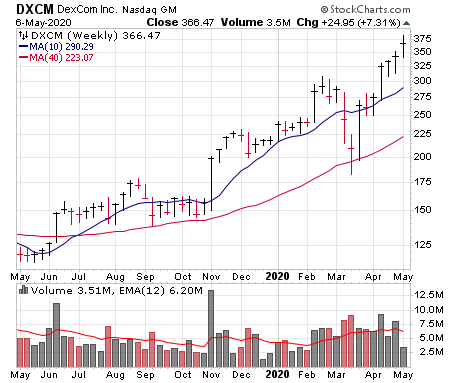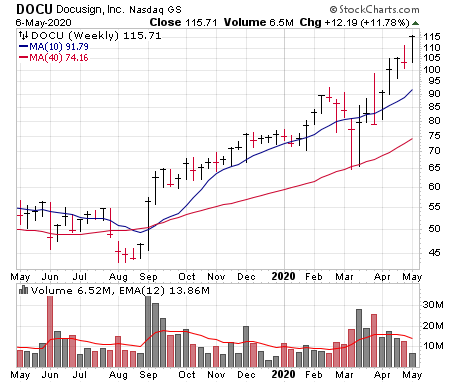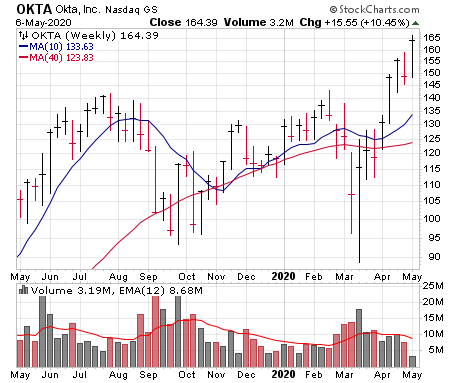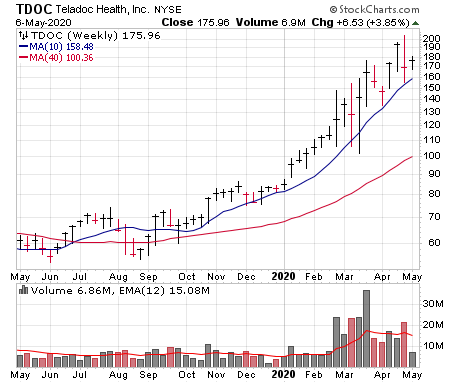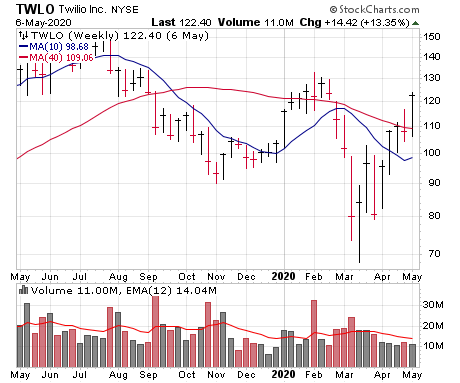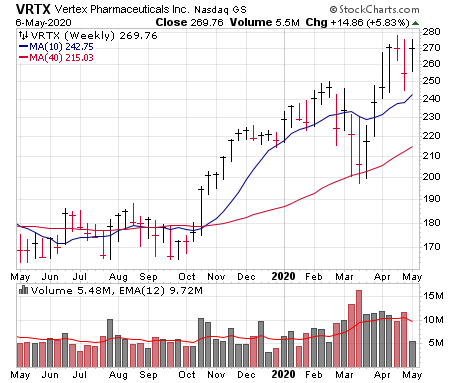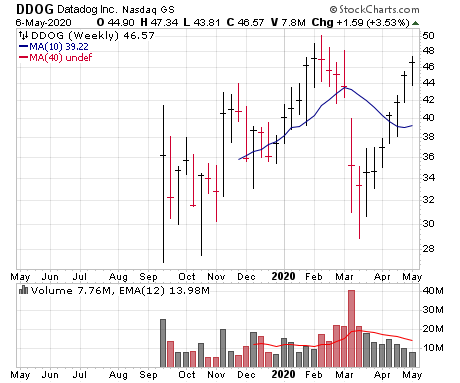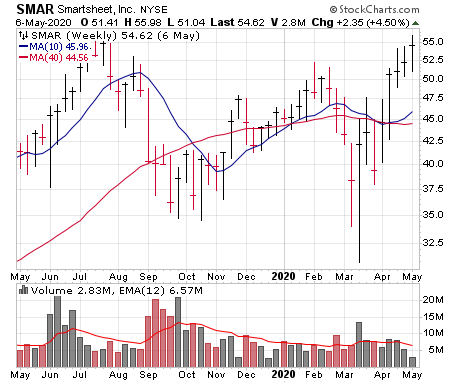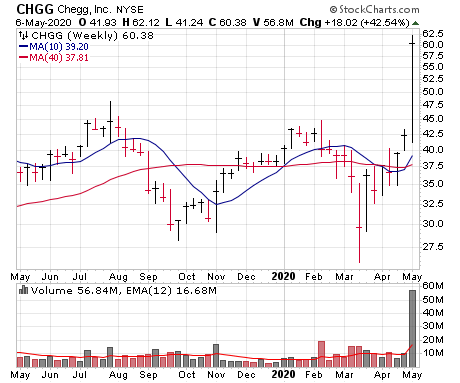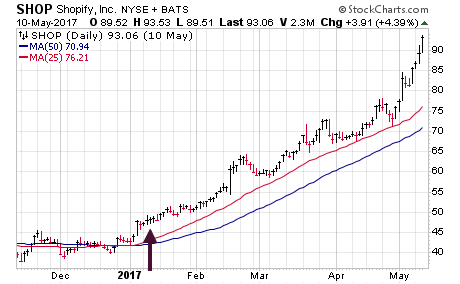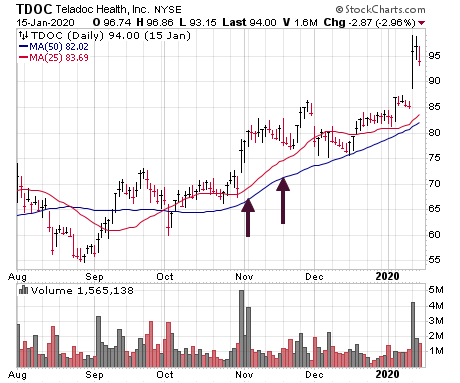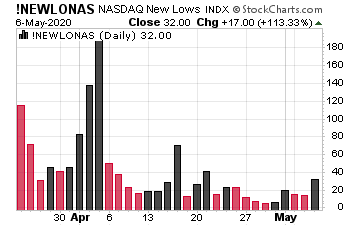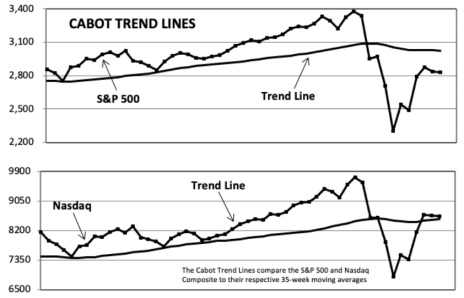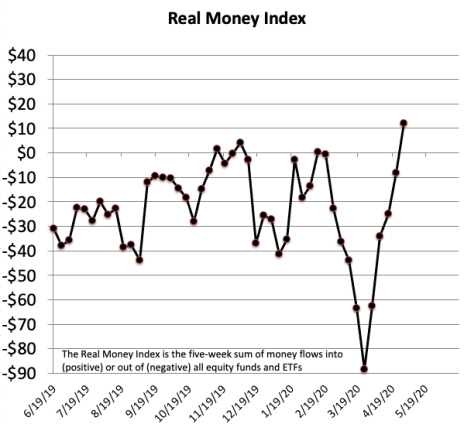The overall market remains mixed, with most of the market doing just OK but growth stocks acting very well, especially this week, which has brought with it a ton of powerful gaps. Divergent environments lend themselves to rotation and potholes, so we don’t think it’s a time to floor the accelerator, but we are adding one more name to the Model Portfolio tonight, leaving us with around 36% in cash.
Elsewhere in tonight’s letter, we write about the importance of being patient soon after you buy a stock, as well as some very encouraging action from our old Two-Second Indicator. We also review some enticing names and give a full view of all our stocks.
Cabot Growth Investor 1445
[premium_html_toc post_id="204745"]
Growth Stocks vs. Everything Else
When stocks were falling apart in late February and early March, the market was obviously very uniform—that is, everything was moving together, in this case straight through the floor. Near the lows, for instance, less than 4% of stocks on the NYSE and Nasdaq were above their 50-day lines! Usually, when you see such uniformity on the way down, you get it on the way back up, too—the same forces that led to the crash almost always means that, when those forces reverse, everything goes back up the chute.
But as has been the case with so many things, 2020 hasn’t followed the usual script. The market is now seven weeks off its crash lows, but it’s a relatively divergent scene—growth stocks, while not without some potholes, are beginning to light up the sky, with a ton of earnings gaps and breakouts seen this week. Even though we came into this week with just under half in cash, we’re not complaining; the Model Portfolio is up double digits on the year.
However, the rest of the market is just OK—small caps, mid caps and many economically-sensitive areas (financials, transports, industrials) did bounce off their lows, but haven’t made much progress over the past four weeks.
“But Mike, you’re a growth guy, so who cares that much about the rest of the market?” Well … that’s true to a point, and indeed, we’re adding one new stock in the Model Portfolio tonight as the action in names we own and watch is too good to pass up.
Still, the reason the rest of the market matters is that (a) a uniform advance is often the healthiest and the longest lasting, and (b) when things are divergent, there’s a greater chance of meaningful potholes and/or significant, sudden rotation—something we’ve seen a couple of times already during this rally and, following a huge run in growth stocks, could occur again at any time.
All this said, we don’t want to overstate the case. Despite the sluggish action, it’s not like the broad market is falling apart—the number of stocks hitting new lows has been very tame for the last month, which is usually a good sign, especially when it comes after a market wipeout. (See more on that later in this issue.) More importantly, our Cabot Tides remain positive and other measures (like Cabot’s Aggression Index) are also pointed up.
Long story short, there’s certainly more positive evidence than not, so we’re optimistic—but we’re also picking our spots.
What To Do Now
We’ve stood pat in the Model Portfolio for the past couple of weeks, and happily most of our names are in great shape. Tonight we’re adding another old friend to the portfolio—Twilio (TWLO) soared out of a huge launching pad after earnings today, and we’ll buy a full position tonight. Our cash position will be around 36% after the buy.
Model Portfolio Update
It’s been a choppy two and a half weeks since our Cabot Tides buy signal, though this week has seen growth stocks go bananas, with a ton of earnings gaps and just good old fashioned buying. As we wrote on page 1, the overall environment is still relatively divergent, so we still think it’s appropriate to go relatively slow on the buy side.
However, while the evidence is mixed, there are plenty of bright spots out there. All in all, we remain optimistic that the next big move is up, and while we’re mentally preparing for some shakouts and potholes, we can’t ignore the strength among so many names that are just emerging from big bases. Tonight, we’re adding Twilio (TWLO), which looks like a fresh liquid leader after a tough 10-month rest and today’s earnings gap.
Current Recommendations
| Stock | No. of Shares | Portfolio Weightings | Price Bought | Date Bought | Price on 5/07/20 | Profit | Rating |
| Chewy (CHWY) | 1,595 | 4% | 45 | 4/20/20 | 39 | -12% | Buy a Half |
| Cloudflare (NET) | 2,715 | 5% | 26 | 4/20/20 | 30 | 13% | Buy a Half |
| Dexcom (DXCM) | 386 | 10% | 216 | 11/15/19 | 404 | 87% | Buy |
| DocuSign (DOCU) | 1,310 | 10% | 65 | 9/13/19 | 118 | 81% | Buy |
| Okta (OKTA) | 947 | 10% | 150 | 4/20/20 | 170 | 13% | Buy |
| Teladoc (TDOC) | 631 | 8% | 78 | 11/01/19 | 175 | 124% | Hold |
| Twilio (TWLO) | New | — | — | — | 171 | — | Buy |
| Vertex Pharmaceuticals (VRTX) | 414 | 8% | 199 | 11/8/19 | 270 | 35% | Buy |
| CASH | $661,274 | 46% |
Chewy (CHWY 39)—CHWY is pretty much the poster child for some of the choppy action we’ve been seeing. The stock was tightening up nicely after a big move, then out of nowhere it collapsed on Monday on huge (triple normal) volume. And then on Tuesday, it rebounded most of the way back on even heavier (nearly quadruple) volume … all on no news! It’s gyrated further since, but despite all the movement, shares have done nothing wrong (the 50-day line and our loss limit are down in the 35.5-36 area), and ideally, this was the shakeout the stock needed before resuming its upmove. Nothing has changed with the story, which has both short-term (more buying online due to the shut-in) and long-term (huge pet supply industry moving online) catalysts. If the stock breaks below our stop, we’ll take the loss on our half position and move on, but right here we think CHWY’s uptrend is intact and the next big move is up. If you don’t own any, you can buy a half-sized position around here. BUY A HALF
.
Cloudflare (NET 30)—Cloudflare is continuing its expansion, inking a deal with e-commerce giant JD.com to spread its network into another 150 data centers in China, up from just 17 today (which is thanks to a partnership with Baidu), giving it a real foothold in that fast-growing cloud market. The stock had admittedly been sluggish, though as we write later in this issue, many stocks don’t move exactly on the time frame you want; many bigger winners futz around for a bit before getting going. Like nearly every potential leading growth stock, NET hasn’t done anything wrong, and now the buyers are showing up—after dipping right to its 50-day line (now near 22.7) late last week, shares have bounded higher, bolstered by a positive quarterly report from Fastly (FSLY), which is a loose peer. That’s obviously good, but Cloudflare will release its own report tonight, and the reaction in the days ahead will be telling. Overall, we like what we see, and will officially stay on Buy a Half, but we’ll let you know if anything changes after the report. BUY A HALF.
Dexcom (DXCM 404)—Given our uncertainty-riddled world, Dexcom released about as bullish a quarterly report as possible, which (along with last night’s announcement that it’s joining the S&P 500) has sent the stock nicely higher. In Q1, sales rose 44% from a year ago, crushing estimates, and just as importantly saw strength from every angle (U.S. and international sales; pharmacy uptake; new patient adds). Earnings, too, easily surpassed Wall Street’s guess (44 cents per share, up from a loss a year ago), and while management yanked guidance for the rest of the year (not unusual nowadays), they did say that the drop in new patient volume in April was only about half as bad as feared, and that they’d already seen a pickup in new patients late last month. Also helping was a regulatory change that will likely make it easier for COVID patients to get coverage for continuous glucose monitors; it’s likely not a major deal but everything helps. Analysts are still only looking for this year’s earnings to rise about 17%, though we think that’s probably conservative given Dexcom’s history of trashing estimates, and 2021 is almost surely going to bring a huge acceleration (40% to 50% earnings growth). In response to all of this, DXCM has gone vertical, so if you want to trim a few shares, there’s nothing wrong with that. (Even the 25-day line is way down around 313.) We could take a couple of chips off the table if the advance continues, but having already shaved one-third of our original position, and with the market certainly not in an extended advance, we’ll sit tight. As for the rating, we’ll stay on Buy, but aim for a shakeout of a few percent at least. BUY.
DocuSign (DOCU 118)—There’s not much new to say about DOCU fundamentally that hasn’t been said before; the only tidbit that’s been released of late was that the firm completed its modest ($188 million in cash) buyout of Seal Software, which offers an analytics and machine learning app that DocuSign helps distribute. The stock has had a couple of sharp, short dips, including last week’s quick 10-point drop, but the overall uptrend is strong and the stock has easily pushed to new highs this week. Similar to DXCM, this stock is extended at this point, so we think aiming for dips of a few points to enter is your best bet. Earnings are likely out in early June. BUY.
Okta (OKTA 170)—Okta is off to a solid start for us, which always helps, though we’re sure that earnings (due out on May 28) will have a big say in the stock’s intermediate-term future. Still, beyond the coming report, we remain very optimistic that this company has a shot at being the Salesforce or Workday of cybersecurity in the cloud era. Okta has enormous expansion potential in terms of both grabbing new clients (just over 20% of the Global 2000 are customers) and growing within existing ones (same-customer growth rate of 19% last year) and from both its workforce identity (77% of revenues, growing at 41%) and customer identity (23% of revenue, but growing at 68%) business lines. And as that happens, profitability and cash flow should mushroom; at its Investor Day last month, management said that customers that signed up in 2016 produced a -47% margin that year (as the firm spent money marketing and setting up new clients), but the next year that jumped to a +40% and now Okta is earning a 70% margin on those clients as they’ve stuck around and added services. Back to the stock, we like the potential after shares rested for nine months and likely wiped out most weak hands with March’s over-the-falls decline. We’re OK buying here or on weakness of a few points. BUY.
Teladoc (TDOC 175)—There’s no question that Teladoc’s business is going to get a lot bigger. Sure, that’s been bolstered by the virus shut-in, but more and more signposts tell us that telehealth has hit an accelerating acceptance phase. The firm’s Q1 revenues leapt 41% from a year ago and management hiked full-year guidance by about 14% as Teladoc onboarded six million subscribers (and anticipates adding another six to seven million in Q2). And it’s not just new members driving things; management said new registrations grew 125% in the quarter vs. “only” a 70% gain in paid and visit fee subscribers, a sign of increasing utilization among those who already had access. Another interesting nugget: While total visit growth obviously accelerated as the shut-in took hold in March, demand for specialist care like dermatology and mental health picked up at even faster rates. (Mental health unfortunately looks like a big opportunity as people deal with job loss and the like.) As for the stock, it mushroomed up above 200 for a few hours before a sharp selloff pre- and post-earnings, but it stabilized above its 50-day line (now near 154) and has started to perk up again. Having already taken partial profits three times, we’re giving our remaining shares plenty of rope. Given that earnings are out of the way, we could restore our Buy rating if we see a decent setup, but right here, we’ll just stay on Hold. HOLD.
Twilio (TWLO 171)—Twilio was one of the leaders coming out of the 2018 market crash and we rode it to solid gains last year before it went into a tailspin in August. Yet the company’s story has always been pristine: It has the leading communications platform for businesses of all sizes (it has 190,000 customers, up 23% from a year ago), allowing them to easily and automatically be in touch with and alert employees, vendors, customers and suppliers in a variety of ways (messaging, email, etc.). Revenues are mostly usage-based, too, so as customers further integrate the platform into their daily operations, Twilio’s top line grows (its same-customer growth rate was a whopping 35% in Q1). Growth has been rapid for a while, though big investments have kept a lid on earnings, but now the market is looking ahead and seeing great things; after sales and earnings crushed expectations last night (management also significantly boosted Q2 guidance), the stock gapped all the way back to new highs. The virus shut-in has helped business more than it’s hurt (firms like Uber and AirBnB are obviously seeing less usage, but others have more than made up the slack), but this is more than a virus play: Twilio’s platform has massive potential as firms large and small (we even use it for alerts on our various options services) automate communications. As for the stock, it’s been dead as a doornail for 10 months, but this morning’s gap is attractive. Of course, there’s risk, and we expect volatility, but buying a big, liquid, well-sponsored (920 funds own shares, including many top-rated ones) growth stock that’s gapping out of a huge base on earnings is something we’re comfortable taking a swing at. We’re adding a full (10% of the portfolio) position tomorrow. BUY.
Vertex Pharmaceuticals (VRTX 270)—In a world where most companies are yanking guidance and building cash in case things get worse, Vertex is a breath of fresh air for big investors, not just beating up on Q1 estimates but also meaningfully hiking guidance for its cystic fibrosis products (mostly Trikafta). And, as opposed to what we wrote last week, it turns out analysts have hiked their estimates for next year by a decent amount (now looking for nearly $11 per share, up a buck from before the report). And there could be more catalysts on the way—a European regulatory body had a positive opinion on expanding one of Vertex’s CF drugs (Kalydeco) to children as young as six months who have a specific gene mutation. VRTX shook out relatively hard before earnings, but found support at its February high (245-250) and has bounced nicely since. It won’t be the fastest horse, but we think the stock will continue to trend higher. BUY.
Watch List
- Chegg (CHGG 59): CHGG gapped up massively after its Q1 report this week revealed wildly accelerating demand for its online, on-demand learning platform. See more below.
- Coupa Software (COUP 194): Whether it’s Coupa, Atlassian (TEAM) or Smartsheet (SMAR, see below), cloud stocks have begun to break out. The next pullback in the sector could be buyable.
- Datadog (DDOG 50): DDOG has rounded out a nice base and is showing persistent accumulation (working on seven up weeks in a row). It’s got a great story, but earnings are due next Monday (May 11). See more below.
- Inphi (IPHI 99): IPHI looks like a real leader, and it’s recovering nicely from a short, sharp, early-stage pullback. If it comes through earnings (due out tonight) in fine shape, we could take a position.
- Netflix (NFLX 437): NFLX had a sharp shakeout after earnings, but it held prior support and has bounced back close to new high ground. There aren’t many firms with earnings estimates (up 56% this year, up 32% next) as big as you see here.
- Wingstop (WING 123): WING released a great quarterly report, with Q1 sales (up 19%) and EBITDA (up 18%) cranking ahead, and more important, with domestic same-store sales up a whopping 33% (!!) in April. The stock is extended but any retrenchment would be tempting.
Other Stocks of Interest
Datadog (DDOG 50)—Datadog was one of two potential new leaders (the other was Dynatrace, which we owned in February) in the application performance management (APM) and infrastructure monitoring space—both fell off a cliff with the market in March, but the need for these solutions isn’t going away (in fact, demand has likely accelerated as the shut-in boosts cloud usage), and of the two, Datadog has bounced back the best. As you might remember, the whole APM story is a follow-on opportunity born by the movement to the cloud—as big companies implement dozens of new cloud-based apps, it’s become a herculean task to monitor their performance and, if necessary, troubleshoot and optimize them, not to mention gain insights on their usage and trace specific events that could become issues. Datadog’s platform solves this puzzle for IT teams, and it’s been a huge hit—revenues have been growing in the 80%-plus range for many quarters, and the sub-metrics are just as impressive, with the same customer revenue growth rate north of 30% (thanks to a continuing increase in new offerings on the platform; 60% of customers now use at least two products), resulting in 858 customers that give Datadog more than $100,000 per year (up 89% from a year ago). Adoption of the platform probably will slow down short-term due to the shut-in, but there’s little doubt that demand will remain strong for many years to come. As for the stock, it broke out of a post-IPO base in January and moved up nicely for a while before the market yanked it down. But since the low, DDOG has marched steadily higher and is now approaching virgin turf. Earnings are due out May 11. DDOG is back on our watch list.
Smartsheet (SMAR 56)—Cloud software stocks have been coming to life, and one of our favorites is Smartsheet. The story is relatively simple but powerful—the firm’s offerings help streamline and automate workflow for any enterprise, making it much easier to plan, automate, share (through customized portals), edit and report (via dashboards) on the progress of any project (or combination of projects) within an enterprise, often linking multiple departments and even groups outside the organization. The big idea here is that Smartsheet’s platform will become the “execution hub” across many applications—basically anything of note that is happening at a company could be tracked using the firm’s wares. The move to a more mobile workforce was making the company’s offerings a must-have anyway, and the virus shut-in will likely help. Revenues have been expanding at a 50%-plus rate for a while (same with billings), while its same-customer growth rate has averaged 34% over the past five quarters. Earnings are still in the red, but as with many software firms, free cash flow is in better shape and improving nicely. As for the stock, SMAR came public in mid-2018, after most of its peers, so it really only had one good run (January through July 2019) in its life—meaning it’s not as well known. More important was the stock’s huge-volume support seen at the lows in March, it being up seven of eight weeks since then, and recent push to all-time highs. It’s worth keeping an eye on.
Chegg (CHGG 59)—CHGG is another firm that’s had a great underlying business for a long time, but its stock stagnated for more than a year as it digested its prior move. But now it’s off and running again after a monstrous earnings gap following this week’s quarterly report. As for the story, Chegg has the leading online learning platform for students, with on-demand and personalized services that cover homework help (including a library of 37 million pieces of content and 31 million expert Q&A answers), writing, math, tutoring and some online skills-based courses, along with textbook and e-textbook services (though it operates those at breakeven). The company is attacking a giant market (36 million U.S. university and high school students, as well as 18 million others in Canada, Australia and the U.K. as it expands overseas), and its offerings have been a hit, with 90%-plus saying they help produce better grades. Growth has been consistent for years, and the shut-in has accelerating that—in Q1, services (not textbook) revenue and EBITDA both lifted 33%, the subscriber total (now 2.9 million) grew 35%, and management forecasts subscriber growth will accelerate to 45% in Q2. To be fair, the top brass isn’t comfortable forecasting full-year results due to uncertainty concerning back-to-school season, but there’s no question business is strong and getting stronger, and that’s been enough for big investors—CHGG exploded out of a year-long base this week on incredible volume following results. Shares can be squirrelly, so some near-term volatility is certainly possible, but the action is enticing.
Stocks Don’t Always Move on Your Timeframe
The dream scenario when you buy a stock is that, right after clicking the buy button, the stock motors higher by a couple of points by the end of the day. Then it tacks on another few points in short order, giving you a solid profit cushion for any wobbles that appear. Soon after, it gaps up on earnings, and you’re off to the races with a potentially big winner.
This is obviously the goal—and it does happen here and there. When we added Shopify right near the start of 2017, it was smooth sailing right away, never really put any pressure on us and turned into a big winner.
However, if that happened every time, we’d all be rich, and unfortunately that’s not going to happen—much more often, the stock you buy will test you with pullbacks, shakeouts, dips on superficial bad news (analyst downgrades, rumors of competition, etc.) and possibly lagging over a period of time when the major indexes rise.
But it’s usually best to give the stock a chance to do what you thought it could do (go up in a big way) unless it really shows itself to be a dud. Teladoc (TDOC) was a perfect example: We started with a half position on November 1 and the second half on November 15 for an average cost around 78. Around Thanksgiving, it seemed that TDOC was off to the races, but it then suffered a scary, three-day, 12% drop on rumored competition and scuffled from there—a month after our second purchase, we were sitting with a loss despite the market heading nearly straight up during that stretch.
But had TDOC done anything wrong? Nope—it was still holding its 50-day line, and the selling volume was mostly modest compared to the huge-volume breakout right before we entered. Thus, we gritted our teeth, and the uptrend obviously reasserted itself in a big way.
Of course, every pick won’t be a winner and you still have to pull the plug if the stock shows abnormal action. But the point is that stocks don’t always move when you want them to—especially early in a move, they often shake and bake as there are many crosscurrents. That’s why you’re usually better off sticking with the plan and not bailing on a couple of days of discouraging action.
The Two-Second Indicator is (Finally) Speaking Up
We removed Cabot’s Two-Second Indicator from our market timing page a year and a half ago as, for whatever reason, it had fallen off the rails—even during profitable, prolonged uptrends for the market and growth stocks (like 2017), it was regularly flashing red, which made any “real” sell signals (like that in late 2018) hard to believe. Perhaps more importantly, the number of stocks hitting new lows on the NYSE had become uncorrelated with the growth stocks we own, which was the final straw.
However, that doesn’t mean the indicator doesn’t have any value—at market bottoms, for instance, it can spot both tremendous, widespread panic (such as the three straight days of greater than 1,000 new lows in December 2018!) and under-the-surface positive divergences (such as this year, when 2,377 stocks hit new lows on March 12 vs. “just” 805 at the market bottom on March 23), both of which can help us “lean against the wind” when everything is falling apart. Indeed, this year’s positive divergence was one reason we held onto four stocks through the downturn despite three of them hitting the skids.
It can also be useful when it really shows abnormally good action—and that looks to be happening here. Shown below is a chart of the number of new lows on the NYSE going back to the market bottom: You can see that, since a flare-up at the start of April, the readings have been very tame. In fact, they haven’t just been below the magic 40 level for 23 straight trading days (including today), but there have been 20 or fewer on 18 of those days! For good measure, we’ve also included a chart of the Nasdaq’s new low readings, and you can see they’ve been equally as tame, relatively speaking.
First off, such tiny numbers of new lows are a good sign that selling on the broad market remains light and sporadic—obviously, certain stocks, sectors or the major indexes have gotten hit here or there, but we’re not seeing the persistent, widespread pressure on the market that often precedes big downmoves. And second, seeing such tiny readings for such a long stretch after a humongous selling wave is almost always a good sign that the bears have left the building.
Of course, the limitations of the Two-Second Indicator mentioned above still exist, but right now, there’s no question the readings are another factor in the bulls’ favor.
Cabot Market Timing Indicators
The evidence remains mixed, with growth stocks doing well (especially this week) and the intermediate-term trend pointed up, but the longer-term trend is iffy and many areas of the market are just meandering. We remain optimistic, but aren’t flooring the accelerator.
Cabot Trend Lines: Bearish
Our Cabot Trend Lines remain on the negative side of the fence, with both the S&P 500 (which closed last week 6.4% below its 35-week line) and Nasdaq (which closed 1.0% above its line) closing nearly unchanged during the prior two weeks before picking up ground this week. (We need to see both indexes close two straight weeks above their trend lines for a new buy signal.) With the longer-term trend sideways-to-down, it’s a good idea to continue to take it slow.
Cabot Tides: Bullish
Our Cabot Tides remain bullish, but they’re not exactly free and clear; three of the five indexes (including the S&P 400 MidCap, shown here) haven’t made much progress over the past four weeks. From here, a drop of 4% could crack the intermediate-term uptrend, but as always, we don’t anticipate what may come. Right now, the Tides are still positive, which means the odds favor higher prices in the weeks ahead.
Cabot Real Money Index: Neutral
The Real Money Index has rebounded in a big way from its March nadir, with the five-week sum ratcheting up to its highest level in months. That takes it firmly out of positive territory, though it will take another week or two of big buying to indicate investors are getting greedy. At this point, the indicator is in neutral territory.
Charts courtesy of StockCharts.com
The next Cabot Growth Investor issue will be published on May 21, 2020.
Cabot Wealth Network
Publishing independent investment advice since 1970.
CEO & Chief Investment Strategist: Timothy Lutts
President & Publisher: Ed Coburn
176 North Street, PO Box 2049, Salem, MA 01970 USA
800-326-8826 | support@cabotwealth.com | CabotWealth.com
Copyright © 2020. All rights reserved. Copying or electronic transmission of this information is a violation of copyright law. For the protection of our subscribers, copyright violations will result in immediate termination of all subscriptions without refund. No Conflicts: Cabot Wealth Network exists to serve you, our readers. We derive 100% of our revenue, or close to it, from selling subscriptions to its publications. Neither Cabot Wealth Network nor our employees are compensated in any way by the companies whose stocks we recommend or providers of associated financial services. Disclaimer: Sources of information are believed to be reliable but they are not guaranteed to be complete or error-free. Recommendations, opinions or suggestions are given with the understanding that subscribers acting on information assume all risks involved. Buy/Sell Recommendations: All recommendations are made in regular issues or email alerts or updates and posted on the private subscriber web page. Performance: The performance of this portfolio is determined using the midpoint of the high and low on the day following the recommendation. Cabot’s policy is to sell any stock that shows a loss of 20% in a bull market or 15% in a bear market from the original purchase price, calculated using the current closing price. Subscribers should apply loss limits based on their own personal purchase prices.



